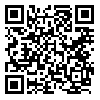Volume 14, Issue 1 (Vol 14, No 1, 2018)
irje 2018, 14(1): 53-62 |
Back to browse issues page
Download citation:
BibTeX | RIS | EndNote | Medlars | ProCite | Reference Manager | RefWorks
Send citation to:



BibTeX | RIS | EndNote | Medlars | ProCite | Reference Manager | RefWorks
Send citation to:
Ahmadpour J, Asghari S, Soltanian A, Mohammadi Y, Poorolajal J. Evaluation of Validity and Reliability of Persian Version of Problematic Internet Use (PIU) Questionnaire. irje 2018; 14 (1) :53-62
URL: http://irje.tums.ac.ir/article-1-5964-en.html
URL: http://irje.tums.ac.ir/article-1-5964-en.html
1- Master of Science in Epidemiology, Department of Epidemiology, School of Public Health, Hamadan University of Medical Sciences, Hamadan, Iran
2- PhD in English Language, Department of Language & Persian Literature, School of Medicine, Hamadan University of Medical Sciences, Hamadan, Iran
3- PhD in Biostatistics, Modeling of Noncommunicable Diseases Research Center, Hamadan University of Medical Sciences, Hamadan, Iran
4- PhD in Epidemiology, Modeling of Noncommunicable Diseases Research Center, Hamadan University of Medical Sciences, Hamadan, Iran
5- PhD in Epidemiology, Research Center for Health Sciences, Hamadan University of Medical Sciences, Hamadan, Iran ,poorolajal@umsha.ac.ir
2- PhD in English Language, Department of Language & Persian Literature, School of Medicine, Hamadan University of Medical Sciences, Hamadan, Iran
3- PhD in Biostatistics, Modeling of Noncommunicable Diseases Research Center, Hamadan University of Medical Sciences, Hamadan, Iran
4- PhD in Epidemiology, Modeling of Noncommunicable Diseases Research Center, Hamadan University of Medical Sciences, Hamadan, Iran
5- PhD in Epidemiology, Research Center for Health Sciences, Hamadan University of Medical Sciences, Hamadan, Iran ,
Abstract: (6725 Views)
Background and Objectives: This study assessed the validity and reliability of the Persian version of the standard "Problematic Internet Use" questionnaire to be used in epidemiological studies.
Methods: This cross-sectional study was performed in 2016. This questionnaire comprises five domains, including preference for online social interaction, mood regulation, cognitive preoccupation, compulsive Internet use, and negative outcomes. The questionnaire has 15 questions with a total score ranges from 15 to 105. A score of 15-45 indicates a normal state, a score of 46-65 shows a mild disorder, a score of 66-85 suggests a moderate disorder, and a score of 86-105 reveals a severe disorder.
Results: Three hundred and seven students (31.1%) had a normal score, 445 (45.1%) had a mild disorder, 191 (19.4%) had a moderate disorder, and 43 (4.4%) had a severe disorder. Based on CVR, 10 questions had a validity of 100%, 3 questions had a validity of 80%, 1 question had a validity of 40%, and 1 question had a validity of zero. The overall validity of the questionnaire was 85.3%. Based on alpha coefficient, the reliability of the domain of preference for online social interaction, mood regulation, cognitive preoccupation, compulsive Internet use, and negative outcomes was 87.6%, 91.1%, 89.8%, 90.8%, and 86.2%, respectively. The overall reliability of the questionnaire was 92.5%.
Conclusion: The validity and reliability of the questionnaire were high; thus, it can be used as a standard tool in epidemiological studies to explore the pathology of injuries related to the Internet and social networks.
Methods: This cross-sectional study was performed in 2016. This questionnaire comprises five domains, including preference for online social interaction, mood regulation, cognitive preoccupation, compulsive Internet use, and negative outcomes. The questionnaire has 15 questions with a total score ranges from 15 to 105. A score of 15-45 indicates a normal state, a score of 46-65 shows a mild disorder, a score of 66-85 suggests a moderate disorder, and a score of 86-105 reveals a severe disorder.
Results: Three hundred and seven students (31.1%) had a normal score, 445 (45.1%) had a mild disorder, 191 (19.4%) had a moderate disorder, and 43 (4.4%) had a severe disorder. Based on CVR, 10 questions had a validity of 100%, 3 questions had a validity of 80%, 1 question had a validity of 40%, and 1 question had a validity of zero. The overall validity of the questionnaire was 85.3%. Based on alpha coefficient, the reliability of the domain of preference for online social interaction, mood regulation, cognitive preoccupation, compulsive Internet use, and negative outcomes was 87.6%, 91.1%, 89.8%, 90.8%, and 86.2%, respectively. The overall reliability of the questionnaire was 92.5%.
Conclusion: The validity and reliability of the questionnaire were high; thus, it can be used as a standard tool in epidemiological studies to explore the pathology of injuries related to the Internet and social networks.
Keywords: Internet, Social networks, Questionnaire, Validation, Validity, Reliability, Injury, Disorder
Type of Study: Research |
Subject:
General
Received: 2018/06/25 | Accepted: 2018/06/25 | Published: 2018/06/25
Received: 2018/06/25 | Accepted: 2018/06/25 | Published: 2018/06/25
Send email to the article author
| Rights and permissions | |
 |
This work is licensed under a Creative Commons Attribution-NonCommercial 4.0 International License. |





